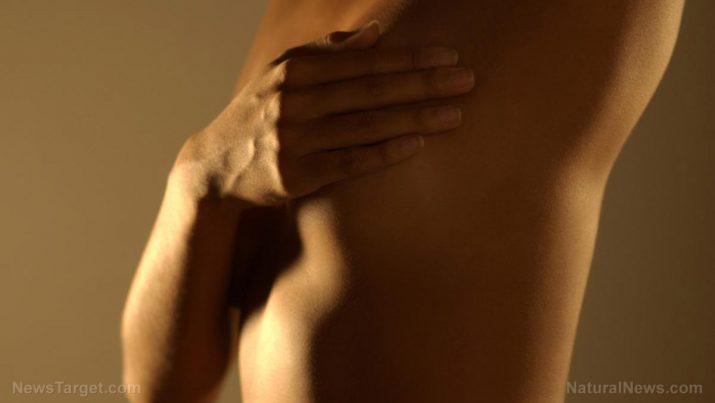
Fibrocystic breasts – causes, side effects and treatments at NaturalPedia.com
Wednesday, March 28, 2018 by Zoey Sky
http://www.naturalpedia.com/fibrocystic-breasts-causes-side-effects-and-treatments-at-naturalpedia-com.html

Fibrocystic breast disease, also known as fibrocystic breasts or fibrocystic change, is a benign or noncancerous condition where the breasts feel lumpy.
Fibrocystic breasts are neither harmful nor dangerous, but they may be bothersome for some women.
Over half of women will develop fibrocystic breasts at one point in their lives. Most female patients with fibrocystic breasts do not experience any symptoms.
While fibrocystic breasts pose no danger, the condition may make it harder to detect breast cancer.

Known side effects of fibrocystic breasts
The side effects of fibrocystic breasts may include:
- Lumps in one or both breasts
- Pain
- Swelling
- Tenderness
- A thickening of tissue
Women with fibrocystic breasts may have more swelling or lumps in one breast than the other. Side effects may also worsen right before a patient’s period begins because of hormonal changes. Patients may also have side effects throughout the month.
Take note that the lumps in fibrocystic breasts often fluctuate in size during the whole the month. These lumps may also be movable. However, if there’s a lot of fibrous tissue, the lumps may be more fixed in one location. Patients with fibrocystic breasts may also experience pain under their arms.
In some cases, women may have either a green or dark brown discharge from their nipples. Consult a healthcare professional right away if your nipples have clear, bloody, or red discharge since this may be a sign of breast cancer.
Any woman may develop fibrocystic breasts, but it usually occurs in women aged 30 to 50. Birth control pills can reduce the symptoms of the disease. Meanwhile, hormone therapy may increase them. The symptoms of fibrocystic breasts will generally resolve after menopause.
Body systems harmed by fibrocystic breasts
While fibrocystic breasts don’t increase the risk for cancer, changes in the breasts may make it more difficult to diagnose potentially cancerous lumps during breast exams and on mammograms.
If you have fibrocystic breasts, consult a healthcare professional immediately once you experience the symptoms below, which may indicate breast cancer:
- Clear, bloody, or red discharge from the nipple
- An indentation or flattening of the nipple
- New or unusual lumps in the breasts
- Redness or puckering of the skin on the breasts
Food items or nutrients that may prevent fibrocystic breasts
The following foods or nutrients may help prevent fibrocystic breasts:
- Fish — Fish rich in iodine will benefit patients with this disease. Sources include salmon and trout.
- Other foods — Vegetables like garlic, mushrooms, and onions are good for the oxygenation of cells, which is crucial for fibrocystic breast change.
- Sea vegetables — Sea vegetables like kelp and nori are full of iodine, a required component of the body. Iodine may also help reduce the swelling in breast tissue.
- Whole-grain foods — Whole-grain foods rich in fiber can help control hormonal disorders or changes linked to fibrocystic breasts. Sources include beans, brown rice, fruits, and whole-wheat bread.
Treatments, management plans for fibrocystic breasts
Since fibrocystic breasts are noncancerous, most women with the disease don’t need invasive treatment. Home treatment is usually enough to address any pain and discomfort associated with fibrocystic breasts.
Over-the-counter pain relievers like acetaminophen (Tylenol) or ibuprofen (Advil) can help relieve pain and discomfort caused by fibrocystic breasts.
Patients with fibrocystic breasts can also try wearing a well-fitting, supportive bra to minimize breast pain and tenderness.
Applying warm or cold compresses may also help relieve the symptoms of the disease.
Some individuals report that minimizing caffeine intake, following a low-fat diet, or taking essential fatty acid supplements help reduce the symptoms of fibrocystic breast disease. Keep in mind that there are no randomized controlled studies which prove that these or any dietary changes effectively relieve symptoms.
Where to learn more
- Study Links Dense Breast Tissue to a Higher Risk of Breast Cancer
- Suffering From Cancer, Thyroid Disease, Chronic Fatigue, Cysts, or Weight Problems? Think Iodine Deficiency
- Symptoms of Hormone Imbalance in Women
- This is what happens when you become deficient in these 3 minerals
- Why are you still doing mammograms?
Summary
Fibrocystic breast disease, also known as fibrocystic breasts or fibrocystic change, is a benign or noncancerous condition where the breasts feel lumpy.
Fibrocystic breasts are neither harmful nor dangerous, but they may be bothersome for some women.
The side effects of fibrocystic breasts may include lumps in one or both breasts, pain, swelling, tenderness, and a thickening of tissue.
Fish, sea vegetables (e.g. kelp and nori), vegetables (e.g. garlic, mushrooms, and onions), and whole-grain foods (e.g. beans, brown rice, fruits, and whole-wheat bread) may help prevent fibrocystic breasts.
Treatment for fibrocystic breasts includes over-the-counter pain relievers (e.g. acetaminophen or ibuprofen), home treatment, and dietary changes (such as minimizing caffeine intake and taking fatty acid supplements).
Sources include
Tagged Under: Tags: fibrocystic breasts





